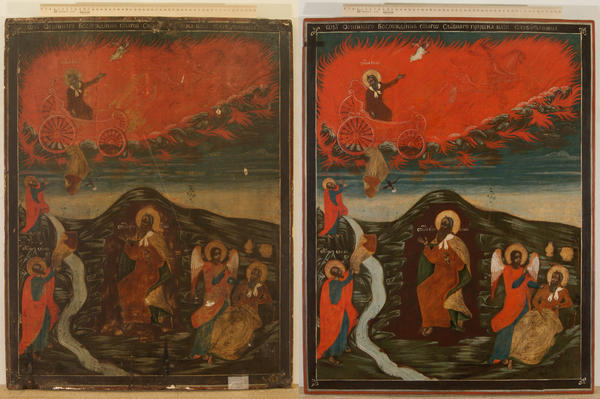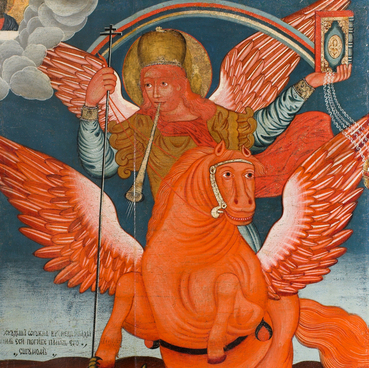Elijah the Prophet is one of the most revered Old Testament prophets in the Christian world. He lived in the first half of the 9th century BC. According to the legends, for his ascetic life and the severe fight against paganism at the end of his days, he was taken alive to heaven in a fiery chariot. In Russia Elijah the Prophet was revered as an augur and a violent accuser of idolism. He was also believed to have miraculous power over the natural forces — storms and clouds, thunder and lightning.
According to the legend, Elijah was supposed to appear on earth before the coming of the Messiah, so in the New Testament he was associated with John the Baptist. And the Elijah’s ascension to heaven, the so-called “Fiery ascension”, is also interpreted as a prototype of the “ascension of the Lord”. The Saint’s commemoration day is celebrated on August 2 in the new calendar style.
The icon ‘Fiery ascension of Elijah the Prophet’ tells us about several scenes from the Prophet’s life. The composition includes two levels, one, the bottom level is the “earth” and the upper one is “heaven”. At the bottom, in the center of the icon, Elijah is depicted in the desert (in a cave), a raven flies up to him and brings him food. According to legend, the prophet fled from persecution, he had to hide and lived in the desert and only a raven saved him from starvation. At the bottom, to the right — an angel appears in front of the sleeping Elijah. At the bottom, to the left — there is a river stream, on the bank of the river there is Elijah’s follower Elisha, he is holding the Elijah’s miraculous cloak made of sheep’s wool, and waving it over the water.
The entire upper part of the composition, ‘heaven’, is occupied by a fiery vortex with swirling flames. Elijah leaves the earth in a horse-drawn fiery chariot. And he throws off his mantle to Elisha, who stands on the ground with his hands raised to the sky.
The color palette of the icon is typical for the Yenisei region icon painting tradition — dark green and green-blue background is complemented by large spots of red and brown colors with the inclusion of ochre and white. ‘Pozyom’ is the conditional image of the earth and it is depicted as hills, the artist painted them applying broad strokes of whitewashed paint. The narrow black borders of the painting are separated from the centerpiece with a white line. The picture is framed with a double white-red border — a thin stripe along the edge.
The icon ‘the Fiery ascension of Elijah the Prophet’ was presented to the Museum in 1984 by the artist Vladimir Kapelko. In 2012 it was restored by Dmitry Ilyin, a restorer of the Krasnoyarsk Art Museum named after V. I. Surikov.
According to the legend, Elijah was supposed to appear on earth before the coming of the Messiah, so in the New Testament he was associated with John the Baptist. And the Elijah’s ascension to heaven, the so-called “Fiery ascension”, is also interpreted as a prototype of the “ascension of the Lord”. The Saint’s commemoration day is celebrated on August 2 in the new calendar style.
The icon ‘Fiery ascension of Elijah the Prophet’ tells us about several scenes from the Prophet’s life. The composition includes two levels, one, the bottom level is the “earth” and the upper one is “heaven”. At the bottom, in the center of the icon, Elijah is depicted in the desert (in a cave), a raven flies up to him and brings him food. According to legend, the prophet fled from persecution, he had to hide and lived in the desert and only a raven saved him from starvation. At the bottom, to the right — an angel appears in front of the sleeping Elijah. At the bottom, to the left — there is a river stream, on the bank of the river there is Elijah’s follower Elisha, he is holding the Elijah’s miraculous cloak made of sheep’s wool, and waving it over the water.
The entire upper part of the composition, ‘heaven’, is occupied by a fiery vortex with swirling flames. Elijah leaves the earth in a horse-drawn fiery chariot. And he throws off his mantle to Elisha, who stands on the ground with his hands raised to the sky.
The color palette of the icon is typical for the Yenisei region icon painting tradition — dark green and green-blue background is complemented by large spots of red and brown colors with the inclusion of ochre and white. ‘Pozyom’ is the conditional image of the earth and it is depicted as hills, the artist painted them applying broad strokes of whitewashed paint. The narrow black borders of the painting are separated from the centerpiece with a white line. The picture is framed with a double white-red border — a thin stripe along the edge.
The icon ‘the Fiery ascension of Elijah the Prophet’ was presented to the Museum in 1984 by the artist Vladimir Kapelko. In 2012 it was restored by Dmitry Ilyin, a restorer of the Krasnoyarsk Art Museum named after V. I. Surikov.


